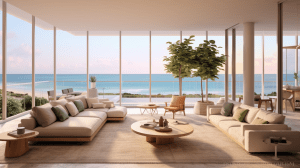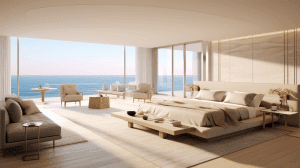5 Elite Home Staging CA Trends in Luxury Design: Expert Insights from LA’s Leading Home Staging Company
In today’s ultra-competitive luxury real estate market, home staging is more than aesthetic enhancement—it’s a strategic lever that drives buyer engagement, accelerates sales, and amplifies property valuations. For brokerage owners and team leaders in California’s luxury segments, mastering home staging trends offers not only improved listing performance but also powerful differentiation in talent recruitment and exit strategy planning.
We interviewed Nicole Senia, Senior Stylist, and Samantha Senia, CEO of Elite Home Staging®, Los Angeles’s premier staging firm, to uncover five dominant trends shaping luxury home staging in California. Beyond design, we dissect how to operationalize these insights into scalable business systems, leverage PropTech tools for hyper-personalization, and connect staging impact to brokerage growth and succession planning.
1. Embracing Timeless Elegance with a Touch of Boho-Chic
Luxury staging in California leans heavily into rich, organic textures blended with the eclectic warmth of boho-chic styles. Nicole Senia reveals that applying neutral earth tones—browns, beiges, and organic wood finishes—creates spaces that feel both sophisticated and lived-in, inviting buyers to emotionally connect with the home’s aura.
“By incorporating rich, warm colors and textures inspired by the 60s and 70s, we create a nostalgic yet sophisticated atmosphere that resonates with luxury buyers,” Nicole Senia explains.
For brokerage leaders, embedding these trends into training materials for staging teams facilitates consistent experiential quality across listings. It also serves as a recruiting differentiator when marketing your brokerage culture as design-forward and buyer-conscious.
2. Colors from the Late 60s and 70s Make a Comeback
The resurgence of warm, retro hues complements the trend toward organic materials and tactile fabrics. This “vintage revival” appeals to segments of the luxury buyer demographic who value nostalgic yet modern environments.
Operational strategy insight: Use buyer segmentation data to tailor staging palettes for each luxury property, leveraging CRM analytics to predict which color stories align with target buyer psychographics. This data-driven approach enhances staging efficacy and speeds decision-making.
3. Simplicity, Sophistication & Focus on Spacing

Samantha Senia stresses that minimalism executed with intent enhances a home’s architecture and high-value features. Curated accessories and cohesive furniture flow yield an atmosphere of effortless luxury. Planning layouts using spatial analysis tools before deployment reduces staging errors and site visits.
“Attention to spacing and a well-thought-out furniture layout creates a seamless flow that elevates the buyer’s experience,” Samantha Senia notes.
Brokerages can systematize these staging protocols and integrate furniture inventory management via digital platforms such as Elite Maison to scale staging across multiple listings efficiently.
4. Always Remember Who Your Buyer Is
Luxury staging is fundamentally buyer-driven. Nicole Senia underscores customizing staging strategies to distinct buyer personas—aligning furnishings, color schemes, and flow with buyer expectations promotes emotional resonance.
Leading brokerages incorporate buyer segmentation data into staging project briefs, utilizing AI-enhanced analytics and PropTech tools for hyper-personalization. This ensures staging not only appeals aesthetically but psychologically connects with prospective high-net-worth individuals.
5. Brand Yourself with a Unique Touch

Samantha Senia advises luxury brokerages create signature staging assets that subtly reinforce their brand presence. Elite Home Staging’s use of branded coffee mugs exemplifies this understated approach that leaves a sophisticated imprint in buyers’ minds.
Integrating unique brand elements into staging initiatives enhances marketing narratives and elevates perceived brokerage value, contributing positively to long-term business equity.
Operationalizing Staging as a Scalable Business System
Beyond aesthetic trends, brokerage leaders must develop scalable operational frameworks for consistent staging excellence. This includes creating dedicated staging teams, standardized processes for staging assessment, supply chain management for furnishings, and stage-to-sale KPI tracking.
Embedding staging within marketing funnels optimizes lead generation—digital campaigns showcasing professionally staged listings command higher engagement and conversion rates. Additionally, staging as a service can be a recruitment differentiator, attracting top agents who value institutional support.
Leveraging AI and PropTech to Enhance Luxury Staging and Listing Performance
PropTech innovations are transforming luxury staging from intuition-driven to data-driven disciplines. AI-powered software enables dynamic 3D renderings, virtual staging, and buyer sentiment analysis to customize staging presentations based on buyer demographics.
Integrating platforms that unify staging logistics with CRM and MLS systems increases efficiency and transparency, essential for managing multi-market luxury operations.
How Staging Influences Brokerage Valuation and Exit Strategy
Staged listings consistently demonstrate faster sales and higher price premiums, directly impacting brokerage gross commission income and profitability margins. This operational maturity elevates the brokerage’s market position and valuation in potential succession or sale scenarios.
Leaders embedding home staging into their business models create defensible competitive moats. Buyers, agents, and investors recognize the value chain enrichment, justifying premium buyouts and increasing legacy outcomes.
Conclusion and Strategic Next Steps
Luxury home staging is no longer simply a marketing tactic; it is a multifaceted strategic asset impacting buyer conversion, marketing efficacy, brokerage culture, and long-term valuation. California luxury brokerages that evolve their staging approach by integrating actionable design trends, operational scalability, buyer personalization, and PropTech tools will lead their markets with clarity and confidence.
Success in luxury real estate leadership requires more than instinct—it demands systems, data, and deliberate execution aligned with legacy-building ambitions.
Top Home Staging Facts and Statistics for 2023
Data from the National Association of Realtors® 2023 Profile of Home Staging reveal:
- 83% of buyers’ agents find staged homes easier for buyers to visualize as future residences.
- Staged homes spend 73% less time on the market than non-staged homes.
- Professional staging can raise sale prices by an average of $40,000 according to a 2021 Seller’s Market Survey.
- Approximately 75% of sellers report staging delivers a 5% to 15% return over asking price.
References
- “Profile of Home Staging.” NATIONAL ASSOCIATION OF REALTORS®, 2023. nar.realtor
- “2021 Seller’s Market Survey.” Real Estate Staging Association®, 2021. realestatestagingassociation.com
- “Zillow Group Consumer Housing Trends Report 2019.” Zillow Group, 2019. zillow.com
- “Home Staging Industry Statistics.” International Association of Home Staging Professionals, 2022. homestagingstats.com
- “10 Virtual Staging Statistics That Will Surprise You.” LCP Media, 2019. lcpmedia.com
- “How Much Does It Cost to Stage a House—And How Much Will You Gain?” Realtor.com, 2023. realtor.com





